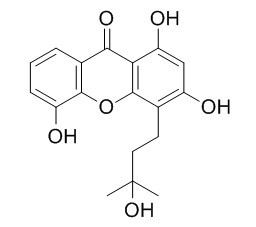1,3,5-Trihydroxy-4-(3-hydroxy-3-methylbutyl)xanthone
1,3,5-Trihydroxy-4-(3-hydroxy-3-methylbutyl)xanthone is a natural product from Cudrania cochinchinensis.
Inquire / Order:
manager@chemfaces.com
Technical Inquiries:
service@chemfaces.com
Tel:
+86-27-84237783
Fax:
+86-27-84254680
Address:
1 Building, No. 83, CheCheng Rd., Wuhan Economic and Technological Development Zone, Wuhan, Hubei 430056, PRC
Providing storage is as stated on the product vial and the vial is kept tightly sealed, the product can be stored for up to
24 months(2-8C).
Wherever possible, you should prepare and use solutions on the same day. However, if you need to make up stock solutions in advance, we recommend that you store the solution as aliquots in tightly sealed vials at -20C. Generally, these will be useable for up to two weeks. Before use, and prior to opening the vial we recommend that you allow your product to equilibrate to room temperature for at least 1 hour.
Need more advice on solubility, usage and handling? Please email to: service@chemfaces.com
The packaging of the product may have turned upside down during transportation, resulting in the natural compounds adhering to the neck or cap of the vial. take the vial out of its packaging and gently shake to let the compounds fall to the bottom of the vial. for liquid products, centrifuge at 200-500 RPM to gather the liquid at the bottom of the vial. try to avoid loss or contamination during handling.
Antioxidants (Basel).2023, 12(12):2131.
Microchemical Journal2014, 203:110804.
Plants (Basel).2022, 11(16):2126.
BMC Cancer. 2021, 21(1):91.
Molecular & Cellular Toxicology2022, 10.1007:s13273-022-00277-3
Biochem Biophys Res Commun.2020, 530(1):4-9.
Mol Biol Rep.2024, 51(1):117.
Molecules.2023, 28(7):3039.
Journal of Third Military Medical University2019, 41(2):110-115
Food Research2022, 6(6): 30-38.
Related and Featured Products
Chem Pharm Bull (Tokyo). 2000 Aug;48(8):1219-22.
Studies on the constituents of Anaxagorea luzonensis A. GRAY.[Pubmed:
10959592]
METHODS AND RESULTS:
Five new xanthones, 1,3,6-trihydroxy-5-methoxy-4-prenylxanthone (1), 1,3,5-trihydroxy-6-methoxy-2-prenylxanthone (2), 1,3,5-Trihydroxy-4-(3-hydroxy-3-methylbutyl)xanthone (3), 1,3,6-trihydroxy-4-prenylxanthone (4), 3,6-dihydroxy-1,5-dimethoxyxanthone (5) and one new flavonoid, 3,5,7,4'-tetrahydroxy-2'-methoxyflavone (6) along with seven known xanthones and seven known flavonoids were isolated from the bark of Anaxagorea luzonensis A. GRAY and their chemical structures were determined by means of chemical and spectral studies.
CONCLUSIONS:
Almost all flavonoids and one xanthone (13) showed antioxidant activity.
J Asian Nat Prod Res. 2007 Apr-Aug;9(3-5):393-7.
Xanthones from the roots of Cudrania fruticosa Wight.[Pubmed:
17613626 ]
METHODS AND RESULTS:
Chemical investigation on the roots of Cudrania fruticosa resulted in the isolation of two new xanthones, 1,6,7-trihydroxy-2-(1,1-dimethyl-2-propenyl)-3-methoxyxanthone (1) and 3,6,7-trihydroxy-1-methoxyxanthone (2), together with three known ones, 1,3,5-Trihydroxy-4-(3-hydroxy-3-methylbutyl)xanthone (3), 1,3-dihydroxy-6,7-dimethoxyxanthone (4) and 3,5,6-trihydroxy-1-methoxyxanthone (5), respectively.
CONCLUSIONS:
Their structures were elucidated on the basis of spectral and chemical techniques.



